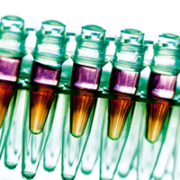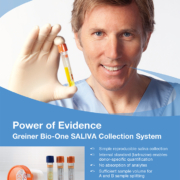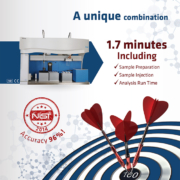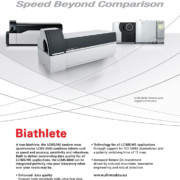Molecular diagnostics – US industry seeks more regulation
Molecular diagnostics is seen as the gateway to an era of personalized medicine. It detects DNA and RNA-level abnormalities that provoke and fuel most diseases. As a result, it offers precise diagnosis, determines the susceptibility of a patient to a specific disease and assesses his or her response to therapy. Moelcular diagnostics can also establish a patient’s prognosis over time far more scientifically than what is often no more than a physician’s informed guess.
Tailored therapy, patient convenience
The track record of molecular diagnostics is, on first sight, impressive.
For instance, FoundationOne, a molecular diagnostic test from Foundation Medicine, scans a patient’s tumour sample for changes in 238 genes that drive cancers, helping oncologists to “choose drugs targeted to the genetic profile of a patient’s tumour cells.”
Another example is Cologuard, from Exact Sciences, which screens stool samples for colorectal cancer. Apart from greater accuracy, the technique is far less invasive than colonoscopy. According to The Mayo Clinic, this will enable more people to get tested earlier and ‘revolutionize’ the fight against colorectal cancer.
Convenience in access is also central to tests from TrovaGene, which utilizes urine samples. Priority targets for the company include malignant melanoma, whose rate of spread makes early detection invaluable, but is also an especially difficult cancer to diagnose via traditional means.
Genomic Health: single-product trailblazer
A poster child of the molecular diagnostic revolution is Genomic Health. The company was founded 15 years ago to close the gap between genomic research and real-life benefits for cancer patients.
Based on the success of a single product, Oncotype Dx, the company has reached a market value of about $1 billion. Oncotype Dx predicts relapse rates of women with breast cancer and assesses benefits from different types of chemotherapy. Its scope has also been extended to prostate and colon cancer.
Targeting broad spectrum of diseases
New molecular diagnostic products, however, go beyond cancer to other challenging conditions. Rheumatoid arthritis is the focus for Crescendo Bioscience, which has developed a test for 12 different proteins in a blood sample of patients. Its metrics are the first to measure molecular activity of the disease and permits a quicker decision to screen for antibodies. The test, moreover, can determine the effectiveness of a cheap, generic steroid such as dexamethasone on a particular patient, as it can about the ineffectiveness of biotech drugs – whose costs range from $1,000 to $3,000 a month.
In some cases, research breakthroughs have allowed firms to offer tests for a variety of diseases out of the same platform. The tests from TrovaGene, for example, are based on proprietary cell-free nucleic acid (cf-NA) techniques – and can be used for cancer as well as infectious disease, organ transplantation and prenatal genetic testing.
Regulation holds key to building confidence
In spite of its strong case, the proponents of molecular diagnostics lament that current use is far below potential. Such arguments have reached fever pitch, especially in the US.
The reason seems ironical. The industry has been calling for more government regulation. An Op-Ed piece in ‘The Boston Globe’ in 2011 explains why. Due to the absence of clear approval policies, it notes, both payers and physicians lacked confidence about the reliability and accuracy of molecular diagnostics. The authors of the Op-Ed, Mara Aspinall, then CEO of an IP-rich molecular diagnostics company On-Q-ity, and Brook Byers of venture capital powerhouse Kleiner, Perkins, Caufield & Byers, were especially scathing about the decision by the Food and Drug Administration (FDA) “to regulate diagnostic tests as ‘medical devices’,” and proposed that molecular diagnostics requires both “new expertise and a new regulatory focus.”
These kind of concerns seemed prescient. Within two years, Aspinall’s On-Q-ity had folded. Following its demise, an industry analyst observed that molecular diagnostics faced similar concerns as therapeutics, but was confronted “by larger reimbursement and regulatory uncertainties.”
CLIA certification and reimbursement
Many molecular diagnostic tests on the US market have not been endorsed by the FDA, or been classified as eligible for Medicare. Indeed, tests approved by the FDA largely concern infectious diseases and companion diagnostics.
Most vendors have their products certified under the less stringent Clinical Laboratory Improvement Amendments (CLIA) standard. Some have succeeded in obtaining Medicare reimbursement, with only CLIA certification. However, this has been lengthy. For example, Crescendo’s rheumatoid arthritis test discussed previously was sold for three years, before being approved by Medicare.
Others have fared worse, in spite of successful products on the market. Foundation Medicine’s tumour test (see above) is neither FDA-approved, nor reimbursed by Medicare. As a result, the company has to negotiate with payers to get paid every time a patient is tested with its product.
Multiple, complex challenges
There are several layers in the underlying problem.
The first is the regulation of diagnostic tests as medical devices. As explained by ‘Expert Review of Molecular Diagnostics’, current regulatory systems were written to regulate a broader array of products, and “molecular diagnostics are now being fitted into that existing framework.” Though there will be overlaps, it is “appropriate to treat molecular diagnostics – properly defined – in a different manner to a group consisting of all other IVDs.” This is clearly not yet the case. A certification program at the University of California, San Diego, for example, notes: “Molecular diagnostics, or in vitro diagnostics …”.
A second regulatory challenge is that molecular diagnostics encompasses both test assays as well as instruments and equipment. The latter are more clearly akin to devices, assays far less so. However, a problem arises when instruments used in assay development are specifically referenced for approvals. A Draft Guidance from the FDA in April 2013 acknowledges such a limitation.
The third factor is the linkage between genomics research on biomarkers, which yields masses of data, but does not provide clinically useful information for real-world molecular diagnostics. This can only be achieved in a gray area between a research laboratory and a clinical laboratory.
Research use only versus diagnostics
The FDA regulates (in vitro) diagnostic kits explicitly designed for diagnostic use. In sharp contrast, research use only (RUO) products are unregulated. Their definition in FDA regulations covers labelling only and is sketchy, specifying that they should be “in the laboratory research phase of development and not represented as an effective in vitro diagnostic product.”
Biomarker assays are usually labelled RUO since their clinical use is unknown, until after their diagnostic effectiveness has been evaluated in a clinical laboratory. Some maintain this status indefinitely, staying outside FDA jurisdiction.
The regulatory problem arises once a clinical laboratory evaluation of a biomarker begins to move on its own course.
From in vitro to molecular diagnostics: difference in detail
As explained by Jeffrey Gibbs of the law firm Hyman, Phelps & McNamara, the roots of the RUO challenge date to the 1990s, when many RUO products began to be used by laboratories for clinical applications. At this time, companies labelled their in vitro assays and instruments as RUO but then promoted them for diagnostic use – in some cases, making specific claims too.
In 1997, the FDA sought to curb this practice with a regulation on analyte specific reagents (ASR), targeting the basic chemical components used in diagnostic assays. However, it became clear some years later that the ASR regulation was being used to camouflage sales of more complex products. In 2007, the FDA issued a guidance document on ASRs, prohibiting the combination of more than one active component.
This, as Mr. Gibbs states, was acceptable for in vitro diagnostics. It was clearly not so for molecular diagnostics, where, for example, a primer and probe pair need to be offered together. To cope with this, a number of companies relabelled their ASRs as (unregulated) RUOs.
In a draft guidance in 2011, the FDA proposed sanctioning companies for selling RUO diagnostic products to clinical labs. Of special concerned were ‘high-risk’ laboratory-developed tests (LDTs) impacting on major treatment decisions – attention to which strengthened in 2011 after the prestigious Duke University used faulty genomic markers to select therapy for cancer patients.
FDA steps in, but industry remains uncertain
The end of 2013 saw a series of major moves by the FDA, which will have a bearing on the shape of the molecular diagnostics industry in the years to come.
One was to shut down health-related genetic tests by direct-to-consumer firms, including market leader 23andMe, which has been selling kits and test results for carrier status, health risks, and drug response.
Another was to provide the first-ever FDA clearance of a next-generation sequencing (NGS) instrument and universal reagents, opening the way for tests to be cleared on their own merits. This may encourage a move by companies of their RUO products into the FDA process.
The FDA also issued a Final Guidance on how companies could market RUO and investigational use only (IUO) diagnostic tests and instruments, which several clinical laboratories had been using for LDTs.
In its Guidance, the FDA backed off from its plans two years before to sanction RUO product sales to clinical laboratories. However, it opens the way for enforcement – and another kind of uncertainty for molecular diagnostic companies, for some time to come.
The Guidance notes that if a manufacturer “were to assist in the validation or verification of the performance of a test for clinical diagnostic use that uses its RUO or IUO labelled IVD, that assistance would be considered to be evidence of a non-research or non-investigational intended use.”
The wording of the Final Guidance leaves considerable room for interpreting the marketing and sales behaviour of both vendors and clinical laboratories. These are likely to be taken up for enforcement actions by the FDA on a case-by-case basis.
As another recent commentary by law firm Hyman, Phelps & McNamara observes, the FDA “says it will take enforcement action based on the totality of the circumstances. What that actually means remains to be seen. As with most things with FDA, we will simply have to wait and see.”












